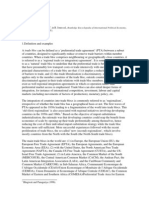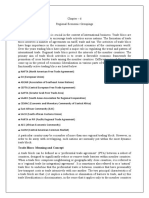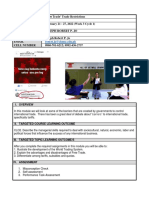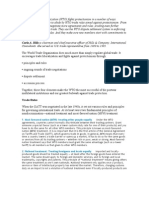Discuss Whether Regionalism (PTA) Is Helping or Hindering The Achievement of Global Free Trade. Building
Discuss Whether Regionalism (PTA) Is Helping or Hindering The Achievement of Global Free Trade. Building
Uploaded by
Anne S. YenCopyright:
Available Formats
Discuss Whether Regionalism (PTA) Is Helping or Hindering The Achievement of Global Free Trade. Building
Discuss Whether Regionalism (PTA) Is Helping or Hindering The Achievement of Global Free Trade. Building
Uploaded by
Anne S. YenOriginal Description:
Original Title
Copyright
Available Formats
Share this document
Did you find this document useful?
Is this content inappropriate?
Copyright:
Available Formats
Discuss Whether Regionalism (PTA) Is Helping or Hindering The Achievement of Global Free Trade. Building
Discuss Whether Regionalism (PTA) Is Helping or Hindering The Achievement of Global Free Trade. Building
Uploaded by
Anne S. YenCopyright:
Available Formats
Discuss whether regionalism (PTA) is helping or hindering the achievement of global
free trade.
Building
1. The agreements allow countries to engage in regional or exclusive free trade cooperation.
When countries are engaged in a PTA, they mutually grant preferential access on goods and
services under the agreement to each other (e.g. charge very low or zero tariffs and exempt
its trading partners from the importing quota). moving free trade
Generally, charging different tariffs rates on different trading partners is considered illegal,
according to the WTOs rules, since it departs from the non-discrimination Most-Favored-
Nation (MFN) rule in Article I of GATT and Article II of GATS.
However, the WTO does permit its members to engage in PTAs, provided that the PTAs
comply with certain conditions. The WTOs rules that allow countries to form PTAs are from
Article XXIV of GATT, which specify that tariffs charged on non-signing countries (i.e. MFN
external tariffs) by a member of a PTA shall not be higher or more restrictive than the
corresponding *tariffs+ of that country prior to the formation of the PTA (Regional Trade
Agreements: Goods Rules, n.d.).
Punyakumpol
2. Easier to form a free trade area among a small number of neighbouring countries
3. Rules at the PTA level then can provide basis for wider multilateral negotiations
- Can experiment with new agreements that are impossible among a large number,
such as the opening of certain types of services that have been traditionally close
for example the Agricultural Industry.
4. Increase in competition can lower costs of production
5. Lower costs arising from economies of scale move towards free trade
6. Increased opportunities for business investment encourage more FDI into the
member countries as the PTA has expanded its market size
In many preferential trade agreements (PTAs) countries exchange not only reductions in trade barriers
but also cooperation in non-trade issues such as labor and environmental standards, intellectual
property, etc.
We find that such PTAs increase the cost of multilateral
tariff reductions and thus cause a stumbling block to global free trade.
The welfare analysis shows that the current WTO rules allowing this type of
PTAs may be optimal for economically large countries
- An alternative to multilateralism
- Is a usefull supplement were only walking on two legs.
- It accelerates the multilateral process
Stumbling
1. Discriminatory against poor and less-developed countries.
- low income countries are unable to negotiate forcefully and often lack resources and
infrastructure that will be needed to take advantage of market opening.
- Pg 19 wp 288. The already cited World Bank report
Weakest partners are the biggest losers.
2. Quicker?
The support of business groups for multilateralism may also erode with regional alternatives
because of two different reasons:
- If one can get a deal regionally, where one may have a great deal of trade, then one may
forget about the multilateral arena. Why bother to fight the battles at the Uruguay Round
where the powerful American manufacturing lobbies, zeroing in with the EC against the Far
East, seek instead weaken the GATT rules?
- One may get better protectionist, trade-diversionary deals for oneself in a preferential
arrangement than in the non-discriminatory world of the GATT.
3. Efficient?
Weak states may agree to demands of strong states, in ways which are not optimal from the
viewpoint of the economic efficiency of the world trading system. In turn, these concessions can
distort the outcome of the multilateral negotiations.
4. Some argue that PTAs might cause member countries to charge higher tariffs on non-
members.
5. Preference erosion, or exploitation. Starting from a world in which all nations have MFN
tariffs, the question is whether some group of nations can raise its collective welfare above
the free trade level by forming a trade bloc and thus exploiting other nations. If the answer
is yes, that bloc is a stumbling block on the road to multilateral free trade because the
members would veto global free trade as undermining their exploitation of third nations. In
trade models, the answer is almost always yes, but the answer may depend on the level of
MFN tariffs when the bloc is formed.8 Given Smiths certitude (briefly, that all parties to a
preferential trade arrangement benefit) and Haberlers spillover (postulating that third
nations must lose from such an arrangement), some combination of nations is bound to be
better able to exploit third nations by acting as a bloc. This is almost trivially true if the bloc
can violate its WTO tariff bindings by raising external tar- iffs. After all, the bloc as a whole
has more buying power than its constituents do individually, so it can better exploit
foreigners. Less obvious, but equally true, is that stumbling blocks can be found even when
external tariffs are maintained (as has been the case for all the major postwar PTAs).
6. Hurt third parties (not in the agreement) Trade Diversion
A different perspective is taken by Chang and Winters (2002), who study the effects of
Mercosura trading bloc formed by Argentina, Brazil, Paraguay, and Uruguay in 1991on
export prices to Brazil. They find that Argentinas export prices increased, whereas the
export prices of countries outside Mercosur fell. These price effects indicate that Mercosur
has hurt outsiders while helping Brazil, a Mercosur partner.
Chang, Won, and L. Alan Winters. 2002. How Regional Blocs Affect Excluded Countries: The
Price Effects of Mercosur. American Eco- nomic Review 92 (4): 889904.
7. PTAs might also serve as diffusion mechanisms either directly, in the form of
coercion, or more indirectly, in the form of learning. For example, a growing body of
work treats the EU as a conflicted power (Meunier and Nicolaidis 2006), which
uses its market power (i.e. access to the EUs single market) to coerce weaker powers,
including former colonies, into accepting new types of trade arrangements (Farrell
2005) (for example, European Partnership Agreements with the African, Caribbean
and Pacific group of states). Others consider that the European Community provided
an example for economic integration among countries in Latin America and Africa in
the 1960s (Pomfret 2001), demonstrating how the perceived success of trade
arrangements teach others to adopt similar policies (Krueger 1997).
You might also like
- Task 1Document6 pagesTask 1Anne S. YenNo ratings yet
- Understanding The WtoDocument7 pagesUnderstanding The WtoNabinSundar NayakNo ratings yet
- The Basics of Non-Discrimination Principle WTODocument5 pagesThe Basics of Non-Discrimination Principle WTOFirman HamdanNo ratings yet
- Customs Unions and Free Trade AreasDocument6 pagesCustoms Unions and Free Trade AreasÖzer AksoyNo ratings yet
- Principles of The Trading System - WtoDocument3 pagesPrinciples of The Trading System - WtoJoan Pablo100% (1)
- Principles of The Trading System: Trade Without DiscriminationDocument6 pagesPrinciples of The Trading System: Trade Without DiscriminationDeepak GirotraNo ratings yet
- FIRST READING International Trade AgreementsDocument7 pagesFIRST READING International Trade AgreementsRena MabinseNo ratings yet
- General Agreement On Tariffs and TradeDocument19 pagesGeneral Agreement On Tariffs and TradeTwinkle PerezNo ratings yet
- The Wealth of Nations: DAM Mith Free TradeDocument6 pagesThe Wealth of Nations: DAM Mith Free Tradegirish_gupta509575No ratings yet
- Wto and Devloping CountriesDocument24 pagesWto and Devloping Countrieskj201992No ratings yet
- Final Reaction Paper 1 MFNDocument11 pagesFinal Reaction Paper 1 MFNFazilda NabeelNo ratings yet
- International Trade Agreements - EconlibDocument1 pageInternational Trade Agreements - Econlib86pksqwfcbNo ratings yet
- Theory of Economic IntegrationDocument39 pagesTheory of Economic IntegrationJustin Lim100% (1)
- Economic Integration TheoryDocument39 pagesEconomic Integration Theorycarlosp2015No ratings yet
- Principles of The Trading System: Trade Without DiscriminationDocument5 pagesPrinciples of The Trading System: Trade Without DiscriminationVIJAYADARSHINI VIDJEANNo ratings yet
- The Establishment of The WTODocument7 pagesThe Establishment of The WTOradhikaNo ratings yet
- Some of The Key Reasons For The Emergence of WTODocument4 pagesSome of The Key Reasons For The Emergence of WTOShilpa ShreeNo ratings yet
- Sanoussi Bilal, "Trade Blocs", in R. Jones Ed., Routledge Encyclopedia of International Political Economy, Routledge, Forthcoming (2001)Document10 pagesSanoussi Bilal, "Trade Blocs", in R. Jones Ed., Routledge Encyclopedia of International Political Economy, Routledge, Forthcoming (2001)IrenosNo ratings yet
- ITL Important TopicsDocument11 pagesITL Important TopicsTushar GuptaNo ratings yet
- 8 New Regionalism As Alternative To MultilateralismDocument7 pages8 New Regionalism As Alternative To MultilateralismOlga LiNo ratings yet
- India: 153 Members On 23 July 2008 (1 January 1995Document4 pagesIndia: 153 Members On 23 July 2008 (1 January 1995BHANUDADWALNo ratings yet
- World Trade Organization ProjectDocument42 pagesWorld Trade Organization ProjectNiket Dattani100% (1)
- Gatt and WtoDocument2 pagesGatt and WtoSatya PanduNo ratings yet
- Role of WtoDocument7 pagesRole of Wtomuna1990No ratings yet
- Davis - Do WTO Rules Create A Level Playing FieldDocument38 pagesDavis - Do WTO Rules Create A Level Playing FieldDamián GariglioNo ratings yet
- Wto FinalDocument37 pagesWto FinalNeha SoningraNo ratings yet
- Chapter - 6 Regional Economic GroupingsDocument9 pagesChapter - 6 Regional Economic Groupingskirthi nairNo ratings yet
- Chapter 12 - TRADE BLOCKSDocument8 pagesChapter 12 - TRADE BLOCKSAriel A. YusonNo ratings yet
- Nirup AssignmentDocument6 pagesNirup AssignmentAshwin KaushikNo ratings yet
- What Is Globalisation: Globalisation - Its Benefits and DrawbacksDocument9 pagesWhat Is Globalisation: Globalisation - Its Benefits and Drawbacksbruhaspati1210No ratings yet
- Is Free Trade Beneficial or Detrimental For Developing States?Document8 pagesIs Free Trade Beneficial or Detrimental For Developing States?alexpromoNo ratings yet
- MODULE 6 - 'Free Trade' Trade RestrictionsDocument9 pagesMODULE 6 - 'Free Trade' Trade RestrictionschingNo ratings yet
- BaldwinDocument26 pagesBaldwinDinesh KumarNo ratings yet
- What Is The Basis For Their Support? That Is, What Are The Specific Benefits That Countries Seek by Joining An Economic Bloc?Document5 pagesWhat Is The Basis For Their Support? That Is, What Are The Specific Benefits That Countries Seek by Joining An Economic Bloc?NavaneethReddyNo ratings yet
- Writing SampleDocument11 pagesWriting SampleirontjkimNo ratings yet
- Multi Layer Regional PactsDocument3 pagesMulti Layer Regional PactsHussain Mohi-ud-Din QadriNo ratings yet
- Pitrela Essay - Fresto - TriszkaDocument8 pagesPitrela Essay - Fresto - TriszkaTriszkaNo ratings yet
- ITL Module 5Document25 pagesITL Module 5joy parimalaNo ratings yet
- Bilateral and Multilateral Trade LawsDocument4 pagesBilateral and Multilateral Trade LawsVera CalusinNo ratings yet
- PTA BuildingDocument4 pagesPTA BuildingAnne S. Yen100% (1)
- Chapter 1.1 Trade BlocsDocument61 pagesChapter 1.1 Trade BlocsnaineshmuthaNo ratings yet
- Trade RestrictionsDocument19 pagesTrade RestrictionsAna-Maria NicolescuNo ratings yet
- ECOMACDocument3 pagesECOMACquennieguanco22No ratings yet
- ALE1 2024 Week9 ReadingDocument16 pagesALE1 2024 Week9 Readinglm2055506No ratings yet
- (Cobibcl) Long Quiz 2Document5 pages(Cobibcl) Long Quiz 2Courtney TulioNo ratings yet
- Carla A. Hills Is Chairman and Chief Executive Officer of Hills & Company, InternationalDocument3 pagesCarla A. Hills Is Chairman and Chief Executive Officer of Hills & Company, Internationaljansi2007No ratings yet
- The Millennium Round and Developing Countries: Negotiating Strategies and Areas of BenefitsDocument41 pagesThe Millennium Round and Developing Countries: Negotiating Strategies and Areas of BenefitsJoeNo ratings yet
- Final GATT & WTO ProjectDocument47 pagesFinal GATT & WTO Projectmsms_khatri100% (7)
- Economic Integration 2Document11 pagesEconomic Integration 2tonyikerNo ratings yet
- The Effects of Trade BlocsDocument5 pagesThe Effects of Trade BlocsKalpesh BhagneNo ratings yet
- Lesson Seven International Trade AgreementsDocument5 pagesLesson Seven International Trade AgreementsBen Wekesa100% (2)
- Regional Trade AgreementsDocument8 pagesRegional Trade AgreementsAditya SharmaNo ratings yet
- Gatt, WTO and GlobalizationDocument29 pagesGatt, WTO and GlobalizationGaurav NavaleNo ratings yet
- Important Factors: Most-Favoured Nation (NMF) : This Is The Fundamental Principle of GATT, andDocument14 pagesImportant Factors: Most-Favoured Nation (NMF) : This Is The Fundamental Principle of GATT, andMauricio PadillaNo ratings yet
- Unit 13 - Lesson 8 1 - Economic IntegrationDocument12 pagesUnit 13 - Lesson 8 1 - Economic Integrationapi-260512563No ratings yet
- Free Trade Area: DescriptionDocument4 pagesFree Trade Area: DescriptionAjayKumarNo ratings yet
- HH Gatt SeoulDocument20 pagesHH Gatt SeoulSomayajula SuryaramNo ratings yet
- Globalization Unveiled: Assessing the Impact of the World Trade OrganizationFrom EverandGlobalization Unveiled: Assessing the Impact of the World Trade OrganizationNo ratings yet
- International Trade Subsidy Rules and Tax and Financial Export Incentives: From Limitations on Fiscal Sovereignty to Development-Inducing MechanismsFrom EverandInternational Trade Subsidy Rules and Tax and Financial Export Incentives: From Limitations on Fiscal Sovereignty to Development-Inducing MechanismsNo ratings yet
- PTA BuildingDocument4 pagesPTA BuildingAnne S. Yen100% (1)
- Date US$ SP500 ASX Topix Ftse STDocument14 pagesDate US$ SP500 ASX Topix Ftse STAnne S. YenNo ratings yet
- How Domestic Violence Impact On Children Behaviour in United States Chew Ji Cheng Language and Knowledge Miss Shivani 3 of December, 2014Document11 pagesHow Domestic Violence Impact On Children Behaviour in United States Chew Ji Cheng Language and Knowledge Miss Shivani 3 of December, 2014Anne S. YenNo ratings yet
- BEO 2431 Risk Management Model Case Study 1Document28 pagesBEO 2431 Risk Management Model Case Study 1Anne S. YenNo ratings yet
- Define Systematic Risk: Task 2Document3 pagesDefine Systematic Risk: Task 2Anne S. YenNo ratings yet
- Swot Analysis (Table)Document3 pagesSwot Analysis (Table)Anne S. Yen56% (9)
- MR Assignment 2Document2 pagesMR Assignment 2Anne S. YenNo ratings yet
- 2 Dimension of InnovationDocument1 page2 Dimension of InnovationAnne S. YenNo ratings yet
- Hindering Trade DiversionDocument4 pagesHindering Trade DiversionAnne S. YenNo ratings yet
- Swot Analysis (Table)Document3 pagesSwot Analysis (Table)Anne S. Yen56% (9)
- Assignment 1 PSIDocument5 pagesAssignment 1 PSIAnne S. YenNo ratings yet
- Law EssayDocument5 pagesLaw EssayAnne S. YenNo ratings yet






































































